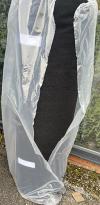Winter Skills and Safety - Walking/Hiking
Mountain Accidents
Every year statistics show that the most common cause of accidents in the hills is the simple slip. Many of the casualties are well equipped but not adequately prepared for the conditions they encounter. Although the mountains of Britain are small when compared to the Alps or the Himalayas, they must be treated with respect - especially in winter conditions with hard snow and ice.
Always take ice axe and crampons and learn how to use them effectively.
Remember also that good navigation is essential to safe mountain travel and that winter conditions can make navigation more difficult. Consider getting some professional training, even two days training can be a life-saving investment.
Use of the Ice Axe
An ice axe is essential when there is snow on the hills and mountains. It is used as an aid to balance, for providing support and ensuring secure footwork, for digging and step cutting and as an emergency brake in the event of a slip. General mountaineering axes have a straight shaft between 50 and 70 cms in length (walking poles cannot substitute for an ice axe).
Holding the Axe
Use the axe to maintain a third point of contact by holding it in the uphill hand (with the pick pointing backwards). This will help to make your footwork more secure. Put your crampons on if your boots don't create steps easily.
Movement on Snow
Remember always to carry your axe in your uphill hand and move methodically and rhythmically, avoiding spurts and stops which lead to poor balance, instability and wasted energy. Use the edge of your boot to kick a step. It is essential that your boots are sturdy and have stiff soles: if you can flex the sole in your hands it's too soft for winter use. Wear crampons whenever your boots don't create steps easily and remember to put them on before getting onto ground where you will be insecure. Always have two points of contact with the snow slope - either both feet (when you move the axe) or one foot and the axe (as you take a step).
Crampons
Always carry crampons when there is snow on the hills even if you think you may not need to use them. Wear crampons whenever your boots don't create steps in the snow easily and remember to put them on before getting onto ground where you would be insecure without them. Boots should have stiff soles and the crampons must fit properly - check they fit before leaving home. Accidents can occur as a direct result of crampons coming loose. Avoid wearing baggy trousers on which crampons can snag and beware of anything hanging down from your waist. Adopt a gait that has the legs farther apart than normal, and practice using your crampons in a safe, controlled environment. You should flex your ankles so that all of the downward points bite. Avoid stamping or dragging your feet. Develop the technique of placing your feet firmly and confidently with each step. Check your crampons are still tightly fitted a few minutes after setting off.
Self Arrest
Self arrest, or ice axe braking, is the technique used to stop a slide on snow or ice. For self-arrest to be effective it must be practised regularly - until it becomes an automatic reaction.
In the event of a slip, the adze of the axe is positioned under your shoulder so that the pick can be applied to the snow slope, with the axe shaft braced across your body. Your feet should be raised so that your toes don't catch in snow causing you to somersault backwards. Only experience will allow you to judge the amount of pressure you need to apply to the pick: too little and you won't stop; too much and you risk losing the axe. Remember that it would be better not to slip in the first place by developing secure footwork.
When practicing, choose a concave slope with a safe run out and no protruding rocks. Avoid slopes which are icy or over 40 and beware of avalanche danger. Start off gently so that you can assess the speed that you will slide. Always wear a helmet and never wear crampons. Be careful not to injure yourself while practicing.
Studies show that poor navigation is the most common contributory cause of all mountain accidents. In winter the weather and conditions make navigation more difficult. Always carry a map and compass per person (1:50,000 or 1:25,000 scale) and practice using them on lower and less serious terrain before going up to the high tops in winter.
The main skills to develop are:-
- Visualising the shape of the ground by interpretation of the contour features on the map.
- Planning a safe route that uses landmarks which you can find along the way. Each landmark should be close to the next one (ideally within one kilometre). Some landmarks may not be visible above the snow during the winter.
- Taking a correct compass bearing from the map and using it accurately on the ground. It takes practice to develop this skill.
- Estimating how far you have traveled since your last known point. This can be done by timing how long you have been walking for or by counting your paces. With practice you can become very accurate.
- Identifying 'catching features' so that you will know what the ground will be like if you overshoot your target.
- Develop 'relocation strategies' in case you lose track of where you are.
Global Positioning System
GPS receivers can be useful but they are not a substitute for the skills shown above. Possible problems include loss of battery power or difficulty with changing batteries in poor weather, cliffs and steep sided valleys can obstruct the signal, and it can be difficult to manipulate the buttons in cold conditions. One of the main advantages is the possibility of acquiring a very accurate Grid Reference of your position.
Route Choice
The winter hills provide endless opportunities for exhilarating and satisfying experiences. Choose a route that will be a challenging adventure but not an epic fight for survival. Think about:-
- The weather forecast.
- The prevailing avalanche risk (see the section on avalanches).
- How long will your route take and will you have enough time to complete it before dark? You can calculate how long the route might take by allowing 15 minutes for every kilometre travelled horizontally and 10 minutes for every 100 metres of ascent. This doesn't allow for any rests or for slow groups or difficult walking conditions. Allow an extra time margin over and above this figure.
- How does your proposed route compare with the last one you did? Is it much further? Are you as fit as you were then?
- Are there likely to be any particular hazards on the route? (steep ground or crags, rivers, difficult navigation, deep snow or icy paths).
- Be prepared to change your plans if the weather deteriorates.
- Don't be afraid to turn back if the situation is becoming difficult.
Weather
Winter weather can turn a relatively straightforward day into a frightening struggle to reach safety. The main factors to consider are:-
- wind direction and strength
- temperature
- precipitation (rain, snow and hail).
The wind strength at Munro height is at least double the sea level strength. Winds of 45 mph and above are difficult to walk in. The windchill factor can make it feel very cold (+ 5° in a 30 mph wind is equivalent to -12°). Winter rain can freeze you and fresh snow can make progress difficult or dangerous.
It is essential to check the weather forecast prior to your trip. Weather forecast sources are:- Radio (local and national), TV, Telephone (recorded forecast), Newspapers, Outdoor Shops, Tourist Information Centres, Internet websites such as the MWIS.
Avalanches
Avalanches can happen whenever there is snow lying on the ground at a sufficient angle. Every year there are avalanche accidents in the Scottish hills. While there is always an avalanche risk in winter, some of these accidents could have been avoided by awareness and planning.
Bear in mind that if there is significant snowfall during a day out, the conditions can change very quickly and make your planned route hazardous. The route which you followed earlier in the day may be avalanche prone when you return.
To find out more information about avalanches, visit Avalanche Safety Advice.
Don't be caught out in winter. You need the following clothing & equipment.
- Boots (stiff soled)
- Crampons (that fit your boots securely)
- Ice Axe
- Map (and map case or clear poly bag)
- Compass
- Waterproof jacket (with hood)
- Waterproof overtrousers
- Gaiters
- Warm hat
- Gloves or Mitts (and spares)
- Thermal top or vest
- Fleece or wool sweater, Spare fleece
- Warm trousers
- Headtorch (and spare bulb & battery)
- Food & Drink
- Emergency survival bag; Whistle, Watch and First Aid Kit (small).
Companions
Make sure your companions are well-equipped and that everyone knows what the plan for the day is. Don't allow your group to split up and never leave someone on his/her own (if one person turns back alone, the remainder of the group will have to spend the rest of the day worrying about whether the person has made it back OK). Travel at the speed of the slowest or least fit person - pushing someone to go faster will only create problems later in the day when fatigue causes mistakes or slips.
A common contributory cause of accidents is disparity within groups - different aspirations and abilities can lead to poor decision making on the hill. Going into the hills alone is generally more serious than going with a group and requires experience and judgement gained from trips made in the company of others and this is particularly true in winter.
Leaving a Note
Leaving information about the day's plans is widely regarded as good practice. The effectiveness of the voluntary mountain rescue teams is greatly facilitated if a reasonably accurate description of a mountaineer's plans is available. It is important to remember that mountaineers do not have a right to be rescued and that their safety is not ultimately guaranteed by the emergency services. A late return, a benightment or a forced bivouac are all situations for which mountaineers should be prepared, and which do not necessarily justify alerting the voluntary mountain rescue services. Mountaineers should be independent, self-reliant and able to look after themselves.
The details to leave in a note are:- time of departure, number of people in the party, brief description of the intended route (with sufficient details that would allow someone else to follow the route) and the expected time of return. Include any possible alternative routes. Details of the action required by the person with whom the note has been left should also be provided. The note should be left with friends, hotel or guest house proprietor, the Police or some other responsible person.
It is absolutely essential that you inform the note holder of your safe return at the end of your trip - otherwise the voluntary mountain rescue services may be alerted unnecessarily. Mobile phones can be useful but it is not always possible to get a signal. Mobiles phones are no substitute for planning and preparation. Mountaineers should be independent, self-reliant and able to look after themselves. If you have to call for help, dial 999 and ask for the POLICE.












